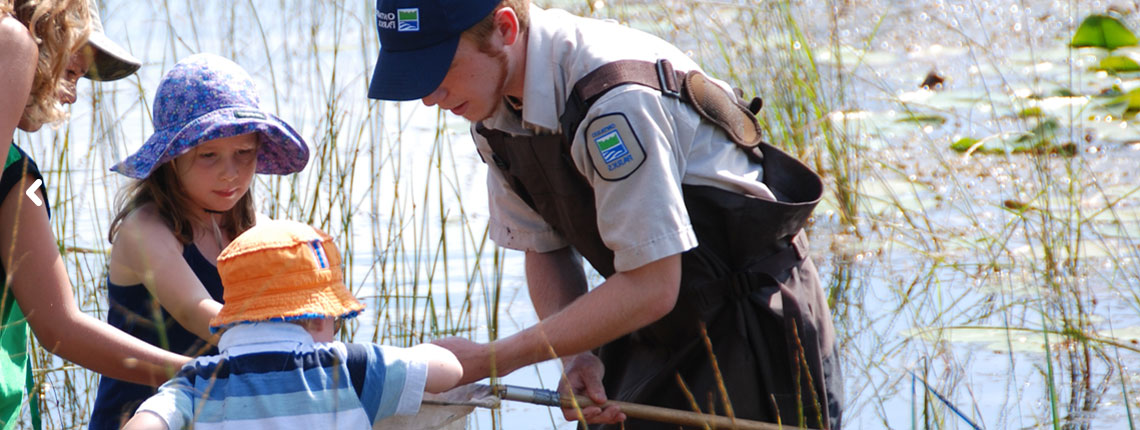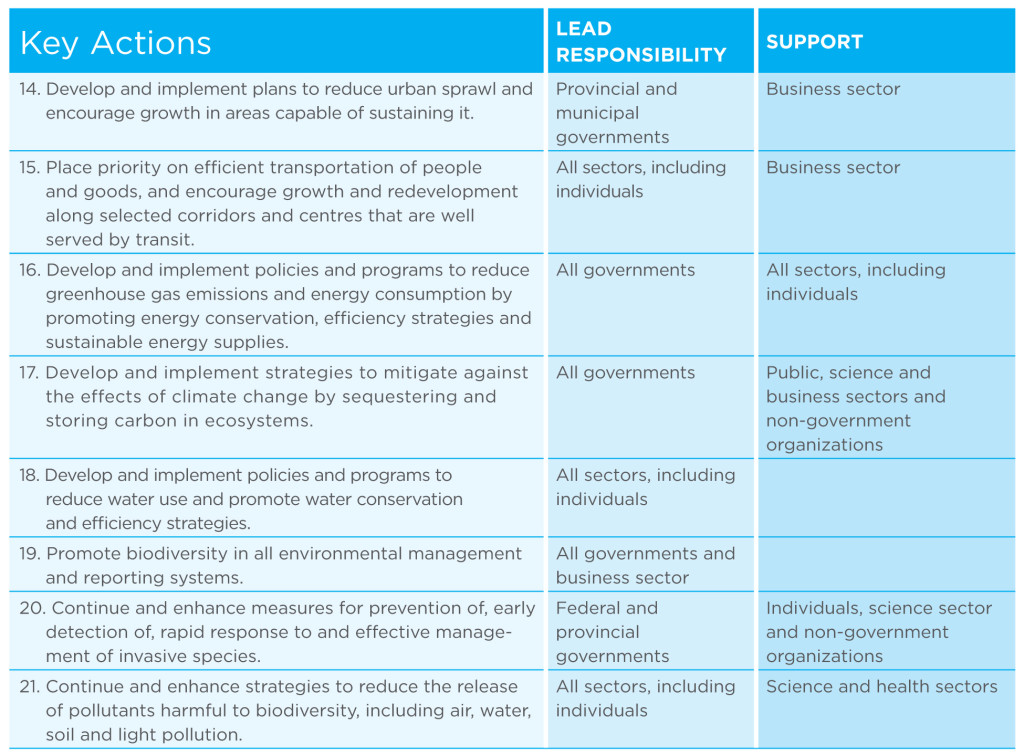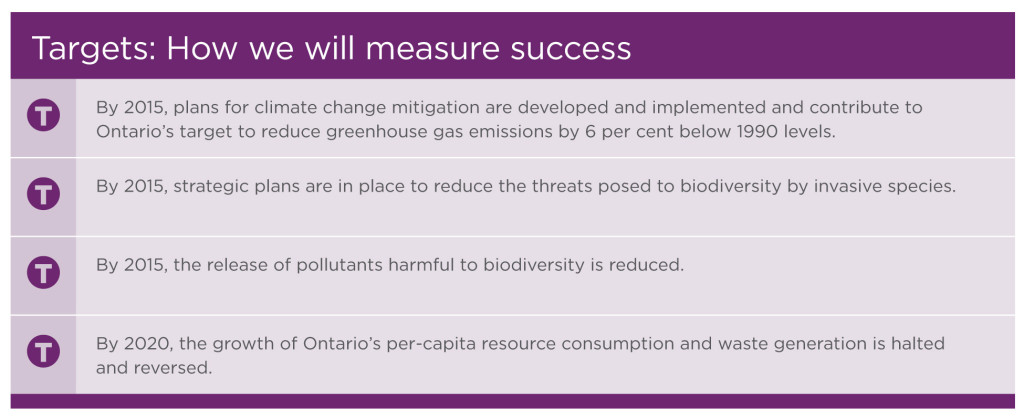
The management and reduction of threats to biodiversity are essential to conserving Ontario’s biodiversity. We can improve the condition of species and ecosystems and help prevent further biodiversity loss by reducing the extent of significant threats to biodiversity and the impacts of existing threats.
Reducing threats will also help to enhance the resilience of our ecosystems and protect the services they provide, which are so vital to our health and well-being. Critical components of this strategic direction include reduction of both direct and indirect pressures on Ontario’s biodiversity, as well as the sustainable use of our natural assets.
Outcomes:
Outcomes:
©
2025 Ontario Biodiversity Council. All Rights Reserved.
Web design by Accurate.
Unsustainable use is the harvesting of species at a rate higher than can be sustained by the natural reproductive capacity of the population being harvested. Unsustainable use can affect genetic diversity, local populations and ecosystems and, in turn, our economy and society. Historically, unregulated and unsustainable harvest was a major threat to several species in Ontario. The development of natural resources management programs, the regulation of harvests through education and effective enforcement and a commitment to conservation among the fishing, hunting and trapping communities have led to sustainable harvest of fish and wildlife species today. The legislative and policy framework for the management of Crown forests also ensures their sustainable harvest.
Programs to manage harvests have been largely successful. Unregulated, unsustainable and/or illegal harvest of some species remains a concern. Outside of protected areas, the harvest of most Ontario plant species is not regulated. For example, the harvest of wild American ginseng, which is used for medicinal purposes, is one of the main threats to this endangered species. Harvest of wild populations is now illegal under Ontario’s Endangered Species Act. Several of Ontario’s protected reptile species are harvested illegally for the pet trade. Although this may not be a widespread problem, the combined effects of illegal harvests and other stressors, such as habitat loss and road mortality, are taking their toll on these species.
The Ecological Footprint is widely recognized as an important first measure of environmental sustainability that is used by governments and institutes worldwide. It measures how much of the Earth’s land and water is required to meet the human demand for natural resources and to assimilate our waste, and it reveals whether our collective consumption levels are approaching or exceeding the Earth’s ecological limits. It is expressed in “global hectares” (gha), standardized units that take into account the differences in biological productivity of the various ecosystems impacted by our consumption activities.
We can determine the Ecological Footprint for an individual or a given population by measuring consumption in four categories: carbon (home energy use and transportation); food; housing; and goods and services.
The Ecological Footprint is directly compared with the region’s biocapacity — the extent and productivity of the key ecosystems to provide materials on a sustainable basis and to absorb carbon dioxide emissions. We can also see how our consumption habits compare with global averages and how they affect cropland, pastureland, forestland and fisheries.
On a per-person basis, Ontario residents’ footprints are high by global standards, ranking 12th when compared to other countries placing the greatest demand on the planet’s natural resources. We are exceeded by Canada which is ranked at number 6. In 2015, the average Ecological Footprint in Ontario was 7.02 gha per-person, which is almost equal to the province’s biocapacity (Miller, et al., 2021).
One of the main pressures on Ontario’s biodiversity is our growing human population (estimated at 14.53 million in 2023), which is predicted to 20.4 million by July 1, 2046 (OMOF, 2022). Population growth increases our ecological footprint – the demand we place on nature. Most population growth will occur in southern Ontario, where the Mixedwood Plains Ecozone is already under significant stress. As the population grows, more prime agricultural land and natural habitats will be converted to urban areas. Poorly planned development can result in urban sprawl and, with it, a continually increasing network of roads and the destruction or fragmentation of natural habitat. In general, population growth increases our total emission of greenhouse gases and pollutants, as well as our consumption of natural resources, which are already in high demand. Without hard work to reduce these pressures, both individually and collectively, biodiversity will continue to be eroded by our growing population.
Ontario residents place high demands on the planet’s natural resources. The average per-person consumption of natural resources in Ontario, as measured by the Ecological Footprint, is very high. Ontario’s per-capita Ecological Footprint (of consumption) in 2015 ranked the 12th highest in the world when compared to other Countries, while Canada ranked 6th (Miller, et al., 2021). We are currently consuming our natural resources at a rate four times the global average and are at the limit of the province’s biocapacity. Our large and growing human population coupled with our high Ecological Footprint are a major impediment to the conservation of Ontario’s biodiversity and have impacts beyond our borders. To reduce negative impacts on biodiversity, we must individually and collectively limit our Ecological Footprint by lowering our consumption and the waste we generate to “fit” within Ontario’s borders.
Ontario’s climate is changing. Ontario is experiencing warming air and water temperatures, increased frequency of extreme weather events, and changing precipitation patterns. Parts of the province have become slightly wetter, and more winter precipitation is falling as rain. Drier summer conditions are being felt in some regions because of reduced snow accumulation, soil moisture, spring runoff and rising temperatures. Many plant and animal species are moving, leading to new species interactions, spread of diseases and declining health.
The impacts are leading to unprecedented and transformative changes to the natural environment, and many changes may be irreversible. Ontario’s ecosystems, communities and resource economies are vulnerable.
We are already observing impacts to Ontario’s biodiversity from a changing climate. For example:
We release pollution into the air (e.g., sulphur and nitrogen oxides, particulate matter), soil (e.g., pesticides and heavy metals) and water (e.g., nitrates and phosphates). Tens of thousands of pollutants are currently circulating through the Earth’s ecosystems, and many of them are having significant, large-scale impacts on biodiversity. For example, pollution is responsible for causing acid rain falling on boreal and deciduous forests and associated aquatic ecosystems.
Pollution can also disrupt ecological processes. Manufactured chemicals and other pollutants contribute to a variety of health issues in both wildlife and humans, including cancer, birth defects, behavioural changes and chronic illness. Synthetic chemicals that block, mimic or interfere with natural hormone production (known as endocrine disruptors) can cause abnormalities in reproduction, growth and development, particularly in fish and amphibians. Some chemicals deplete the ozone layer, which allows more ultraviolet (UV) radiation to reach the Earth. UV rays can be especially damaging to ecosystems in the early spring, when vegetation is young and fish and frogs are laying their eggs in shallow water. Humans and some food crops are also at risk from higher levels of UV radiation (e.g., skin cancer in humans). Our urban and industrial development has increased the amount of light falling on ecosystems and there is a growing concern about this light pollution and its impacts on biodiversity — the disorientation of migrating birds, for instance, or changes in amphibian behaviour and disruptions in plant dormancy.
While the levels of many contaminants have decreased in Ontario, associated with regulatory controls and industry efforts, the deposition of excessive nutrients, as well as metals and other substances remains a concern for many of our ecosystems. Ground-level ozone in the southern portion of the province continues to rise, posing a risk to human health and to the vegetation communities that are fundamental to our biodiversity.
An invasive species can be any plant, animal or micro-organism that is introduced by human action outside of its natural past or present distribution and whose introduction or spread threatens the environment, the economy or society, including human health. When introduced into new ecosystems, invasive species can become novel predators, competitors, parasites, hybridizers, and diseases of native plants and animals. Once established, the ecological effects of invasive species can be irreversible, the costs of control are significant, and even with sustained efforts eradication may not always be possible.
Invasive species are one of the main threats to biodiversity at the global and national levels and are also a significant ecological threat to Ontario. The impact of invasive species to Ontario’s biodiversity is second only to habitat loss. Through their impacts to the natural environment, they pose a significant risk to Ontario’s natural areas and the outdoor recreational activities that they support. Not only do these impacts affect the well-being and ability of Ontarians to enjoy nature, but they also represent a significant threat to Ontario’s economy.
Examples of invasive species that have had negative ecological impacts in Ontario include: Invasive Phragmites which has caused considerable habitat losses for wetland–dependent wildlife, including numerous species at risk; Zebra and Quagga Mussels which have led to significant changes to aquatic ecosystems within the Great Lakes and beyond; and Emerald Ash Borer, an invasive wood-boring beetle that has already caused extensive damage to ash tree populations in Ontario.
Ontario has had more non-native species establish within its borders than any other Canadian province or territory and will continue to be susceptible to invasive species introductions and spread. This is in part because Ontario has a large, diverse population that is both locally and globally mobile, and supports an active, growing economy that imports goods from all over the world. In addition, much of the habitat in southern Ontario has been altered or disturbed, further increasing susceptibility to new invasions. Finally, climate change also poses an additional threat that could facilitate new invasions into Ontario and promote the spread of invasive species that are already established.
Loss of habitat is the primary threat to biodiversity in Ontario. Habitat loss is most serious in southern Ontario, where urbanization, agriculture and road density are greatest — and where some of the province’s rarest biodiversity is found, such as alvars and tallgrass prairies.
Plant and animal species are less resilient to external pressures when the ecological communities of which they are a part of are changed, when populations become isolated from one another or when humans interfere with natural ecological processes (e.g., prevention of natural disturbances such as forest fires or insect and disease outbreaks). Habitat loss, including destruction, alteration and fragmentation, affects the well-being and survival of individual populations, as well as species, and can affect the function of entire ecosystems and the ecosystem services on which we depend.
Resource extraction, hydroelectric power development and the construction of roads and bridges can all impact biodiversity through habitat changes and degradation of local water bodies. Intensive recreational activities can also harm local vegetation, pollute waterways and disturb wildlife. The cumulative impact of a series of seemingly small habitat losses can be significant.



Follow Us
